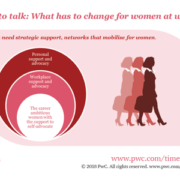OP-Ed: Actions Not Ads on International Women’s Day 2021
 The workplace design of the future is happening before our eyes, as we approach International Women’s Day. What elements of our professional lives will stay, go or morph is a fascinating topic with many facets—from office space to cyber security to creating community, networking and relationships, if things stay mostly virtual.
The workplace design of the future is happening before our eyes, as we approach International Women’s Day. What elements of our professional lives will stay, go or morph is a fascinating topic with many facets—from office space to cyber security to creating community, networking and relationships, if things stay mostly virtual.
What wins are to be had for professional women at this historic juncture? Will this seismic shift ultimately enable structural changes that level the playing field for better diversity and inclusion at work, or are organizations letting disproportionately burdened women slip through the cracks?
Nothing has been brought more sharply into focus than the at-home employee experience, since Covid19 arrived to our cities, towns and places of work about one year ago, creating an almost immediate need to be remote. Just like that, everyone had to figure out how to work, when to work and even, if they could work.
One year on, many smart corporations are reflecting deeply about the employee experience and the future of work. There is a massive opportunity to create the physical and psychological space that people need to thrive and succeed at work, to recognize now what most professional women already knew—that everyone is not in the same boat in this storm. Nuances matter.
In 2020, social issues migrated into work and all the lines blurred. 2021 will only see more of this.
But will corporations finally integrate diversity and inclusion as cultural thriving and treat it with task expectations for all employees? Will they embrace a mindset change with committed actions? It takes courage to tackle the status quo with more than words.
Putting principle into action, Goldman Sachs will only take companies public if they have women on their boards. That is walking your talk and making behavioral and mindset change real.
Actions Are Better Than Words
As we celebrate International Women’s Day 2021 on 8th March, the theme this year is #choosetochallenge—with a hand in the air symbolic gesture—when bias rears its head or when women aren’t heard. While it’s an important message and sentiment, awareness is only the first step in anything, at best, and firms must create real change for all constituents.
Frankly put, work doesn’t work for many people right now.
It is now in plain sight that women, and professional women, are suffering more from the effects of the Covid pandemic, with the US having the biggest amount of women leaving the workforce, followed by Japan. Losses will be hard to recover from. Phrases like shecession may sound glib but the numbers don’t lie, with NPR reporting that women are back to 1988 levels of workforce participation. We want systemic and behavioral change.
Defining your values, really knowing who you are and connecting brand to purpose is the first step. The second step would ideally be walking the talk with actions. Interestingly research shows that sometimes talking the talk is vital to get to finally walk the talk.
Companies who know who they truly are will be able to embody their values better than companies who don’t know where they stand. Nothing became more urgent than to know who you are as when Black Lives Matter entered the workplace last year with employees requesting firms to know who they are.
Acting on your words and connecting meaningful purpose to your employee experience, as part of brand integrity, is what we need now.
If your company was a person, would you want to hang out with them? If they were your friend, would you trust that they would do what they say they believe in?
Seven Suggestions For Acts, Not Ads
So, if your firm wants to actually support you this International Women’s Day, there are simple actions that could show they are serious.
Here are some actions that organizations could take to live their espoused values and step up as leaders:
#1: Give women the option of a paid day off work on International Women’s Day.
Microsoft announced today that employees would get more paid leave due to the pandemic to alleviate having to be everywhere at once, since exhaustion is real and burnout is at an all time high. Working mothers in particular are at their wit’s end.
Several years ago, REI closed its stores on Black Friday and told its employees to live the company slogan “Go Outside” by introducing #Optoutside.
#2: Address the pay gap in your firm for real.
The wage gap, reinforced by static and traditional gender roles, plays a big part for women leaving work. Eve Rodsky, author of Fair Play, and Darcy Lockman, author of All the Rage, both explain the myth of equality between men and women in division of labor at home.
As an organizational psychologist, my take is how you operate at home, and whatever belief system you operate on, is what you take into the office with you—including impressions for both men and women of their gender role and the expectations and boundaries that come with that.
Consider that in 69% of US households where opposite sex partners live together, men are the highest earners. And, weirdly even female CEOs earn less than male counterparts in similar companies.
#3: Make it mandatory that meetings cannot be scheduled between 5.30pm-7.30pm.
These hours are usually dinner, bath and bedtime for employees with kids. Working dads will thank you also. Boundaries are important. Flex work is the new black with fewer taboos now that we know we can use technology easily from almost anywhere.
#4: Ask everyone if products and programs work for them.
Microsoft has included gamers with disabilities to test their games. Needs are different. Test assumptions by asking your constituents what they think.
#5: Ask people if they want to stay remote.
Tsedal Neeley, Harvard Business School’s Naylor Fitzhugh Professor of Business Administration and author of Remote Work Revolution: Succeeding from Anywhere, believes, “We’re definitely going to see a much bigger population working remotely. All the satisfaction comes when people are given a choice. Choice and autonomy are crucial for people to appreciate remote work and the chance afforded them.”
Equally, some people truly do want to return to the office soon, and the future design of the workplace for safe innovation and community has never been more timely. Innovation literally needs fresh space now.
#6: Walk your talk. Get serious. Grow.
Figure out what your real values are and how to live them as a leader of an already diverse workplace. Diversity management is a strategic capability.
#7: Let leaders be vulnerable.
Cancel culture kills vulnerability and prevents learning. We are all on a journey. Allow for correction, remorse and redemption—as we can’t grow if we aren’t given oxygen. And, context is everything.
Equally, know when you see a systemic flaw that tolerates or even creates incentives for ego-wars, control-dynamics, power-grasping and fear-based motivations to win. Change the system so these norms are not the status operating quo.
Will 2021 finally be the year that companies align internal talent process, and create real and meaningful pathways to inclusion and equity for professional women?
Actions not ads. Finally?
#Actsnotads. #IWD
Check our “Acts not Ads” work here: We deploy behavioral psychology techniques to employer brands to see if they really know who they are (values) and then, how they act (behaviors) so that employees can believe them. Audio and visuals have to match.
by Nicki Gilmour, CEO and Founder, Evolved People (theglasshammer.com)









